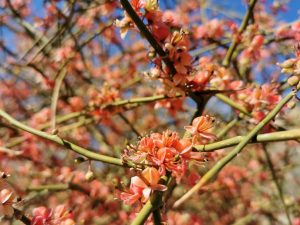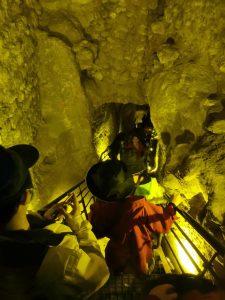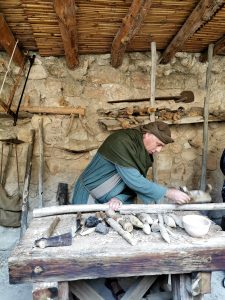A Walk in the Land of the Bible
Dr Elaine Goh | Dean of Studies
The Journey Begins
Ever since I was a young Christian, there was a longing in me to journey to the land of the Bible, visiting towns and cities mentioned in the Bible, such as Bethlehem, Jerusalem, Galilee and Nazareth, and experiencing the streams and waters of the Jordan River, the Dead Sea, the En-Gedi, and the Sea of Galilee. These places remind me of the Lord Jesus.
“As he walked by the Sea of Galilee, he saw two brothers, Simon, who is called Peter, and Andrew his brother, casting a net into the sea– for they were fishermen. And he said to them, “Follow me, and I will make you fish for people.” (Matt 4:18-19 NRSV)
This longing was fulfilled many years later when I went there in 2011, and subsequently led groups of Christians there in 2013 and 2018. After the recent COVID-19 pandemic that had delayed an already-planned departure in 2020, I had the opportunity to lead another group there from late November till early December 2022, and not long after, yet another group from the Chinese TEE from 3-15 March 2023.
We experienced first-hand the places mentioned above, and many more. Walking alongside fellow Christians in these biblical places kindled my heart to be even more passionate about what I do—teach the Bible. The Bible comes “alive” each time I connect the dots between the Bible and the Bible places. Allow me to share here the three most significant connections among my experiences.
Nazareth Cultural Village
|
|
Can we really see the town of Nazareth in the Holy Land today as it used to be during the time of Jesus? The answer is “yes, almost”. Christian workers clothed in first-century Nazareth costumes greeted us with friendly gestures, and allowed visitors to take photographs with them. They explained first-century life, including how to make a stool, build houses, weave clothes, plant vineyards, as well as about carpentry, shepherding, and listening to the reading of Scripture in a synagogue.
When he came to Nazareth, where he had been brought up, he went to the synagogue on the sabbath day, as was his custom. He stood up to read, and the scroll of the prophet Isaiah was given to him. |
The Nazareth village guide spoke passionately about various biblical narratives, such as interpreting what it meant to put new wine into old wineskins, as well as the fact that Jesus might have dealt more with rocks and stones than with wood. For the most recent trip, we missed the opportunity to arrange lunch in the village, but we hope that some of us can enjoy a meal in this ancient Nazareth village setting one day!
En-Gedi: An Oasis Near the Dead Sea
When Saul returned from following the Philistines, he was told, “David is in the wilderness of En-gedi.” Then Saul took three thousand chosen men out of all Israel, and went to look for David and his men in the direction of the Rocks of the Wild Goats. (1Sam 24:1-2 NRS)
En-Gedi is well-known as the hiding place of David when he fled from Saul.
With a luxurious supply of flowing streams, the fragrance of assorted plants and flowers fill the air. The flora and fauna there testify of God’s grace and protection – life is possible even in the wilderness with God’s provision of an oasis so near to the Dead Sea.
My beloved is to me a cluster of henna blossoms in the vineyards of En-gedi. (Songs 1:14 NRSV)

After having been able to only reach David’s Spring previously, this time some of us managed to walk and climb our way to see David’s Waterfall. The journey there and back took barely one hour, and the scenery was simply awesome as we could see the Dead Sea not far from where we were walking. We spotted several hyraxes who were not afraid of our presence, and on one occasion, we came close to a number of ibexes. The En-Gedi experience was a truly refreshing one for us, not only physically, but also spiritually.

Hezekiah’s Tunnel
Located in the old City of David, Hezekiah’s Tunnel has a dry tunnel, as well as a wet tunnel with knee-high flowing water. The City is located on a steep mountainside with a dangerous slope, providing a strong military defence during the reign of king David. Hezekiah’s Tunnel was built during the reign of king Hezekiah when Jerusalem was under siege by the Assyrian army. With his wise leadership and the amazing persistence of his men, labourers from both sides of the tunnel began digging underground and eventually met at the same location, thus making possible the divergence of Gihon Spring to flow from outside the city into the Siloam Pool in Jerusalem.
The rest of the deeds of Hezekiah, all his power, how he made the pool and the conduit and brought water into the city, are they not written in the Book of the Annals of the Kings of Judah? (2King 20:20 NRS)
As we walked through this dark and quiet tunnel, we celebrated the success of this amazing work of underground construction dating from 700 BCE – an ancient achievement and archaeological site that is attested to in the Hezekiah Inscription. We were also reminded that within this very City of David, came Jesus Christ, the Messiah and King who died for us and rose on the third day, and who will one day rule in eternity!
Join Our Study Tour
But there are also many other things that Jesus did; if every one of them were written down, I suppose that the world itself could not contain the books that would be written. (John 21:25 NRSV)
STM is planning an upcoming Jordan & Israel Bible Study Tour (Old and New Testament) from 26 November till 8 December 2023, which will cover faith lessons from the Bible. The Principal, Dr Chong Siaw Fung, will lead this group of English TEE students (and other Christian friends) to visit places of the Old Testament and the New Testament. Similar study tours are slated to be planned annually. Do contact us for details, and join us!
